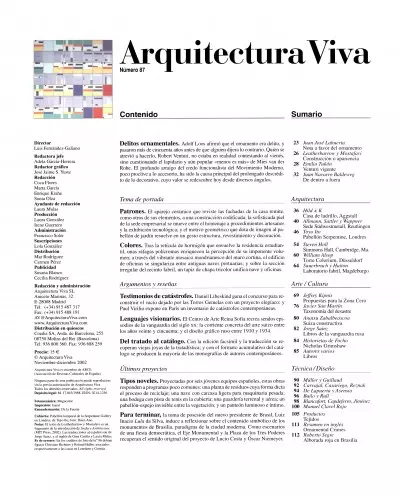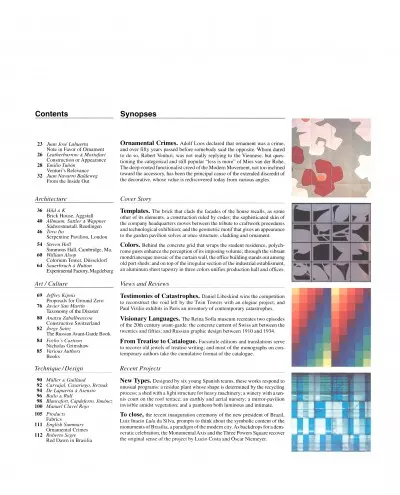Synopses
Ornamental Crimes. Adolf Loos declared that ornament was a crime, and over fifty years passed before somebody said the opposite. Whom dared to do so, Robert Venturi, was not really replying to the Viennese, but questioning the categorical and still popular “less is more” of Mies van der Rohe. The deep-rooted functionalist creed of the Modern Movement, not too inclined toward the accessory, has been the principal cause of the extended discredit of the decorative, whose value is rediscovered today from various angles.
Contents
Juan José Lahuerta
Note in Favor of Ornament
Leatherbarrow y Mostafavi
Construction or Appearance
Emilio Tuñón
Venturi’s Relevance
Juan Navarro Baldeweg
From the Inside Out
Cover Story
Templates. The brick that clads the facades of the house recalls, as some other of its elements, a construction ruled by codes; the sophisticated skin of the company headquarters moves between the tribute to craftwork procedures and technological exhibition; and the geometric motif that gives an appearance to the garden pavilion solves at once structure, cladding and ornament.
Architecture
Hild & K
Brick House, Aggstall
Allmann, Sattler & Wappner
Südwestmetall, Reutlingen
Toyo Ito
Serpentine Pavilion, London
Colors. Behind the concrete grid that wraps the student residence, polychrome gusts enhance the perception of its imposing volume; through the vibrant mondrianesque mosaic of the curtain wall, the office building stands out among old port sheds; and on top of the irregular section of the industrial establisment, an aluminum sheet tapestry in three colors unifies production hall and offices.
Steven Holl
Simmons Hall, Cambridge, Ma
William Alsop
Colorium Tower, Düsseldorf
Sauerbruch & Hutton
Experimental Factory, MagdeburgViews and Reviews
Testimonies of Catastrophes. Daniel Libeskind wins the competition to reconstruct the void left by the Twin Towers with an elegiac project; and Paul Virilio exhibits in Paris an inventory of contemporary catastrophes.
Art / Culture
Jeffrey Kipnis
Proposals for Ground Zero
Javier San Martín
Taxonomy of the Disaster
Visionary Languages. The Reina Sofía museum recreates two episodes of the 20th century avant-garde: the concrete current of Swiss art between the twenties and fifties; and Russian graphic design between 1910 and 1934. Anatxu Zabalbeascoa
Constructive Switzerland
Jorge Sainz
The Russian Avant-Garde BookFrom Treatise to Catalogue. Facsimile editions and translations serve to recover old jewels of treatise writing; and most of the monographs on contemporary authors take the cumulative format of the catalogue.
Focho’s Cartoon
Nicholas Grimshaw
Various Authors
Books
Recent Projects
New Types. Designed by six young Spanish teams, these works respond to unusual programs: a residue plant whose shape is determined by the recycling process; a shed with a light structure for heavy machinery; a winery with a tennis court on the roof terrace; an earthly and aerial nursery; a mirror-pavilion invisible amidst vegetation; and a pantheon both luminous and intimate.
Technique / Style
Müller & Guillaud
Carvajal, Casariego, Reznak
De Lapuerta & Asensio
Bailo & Rull
Blancafort, Capdeferro, Jiménez
Manuel Clavel Rojo
To close, the recent inauguration ceremony of the new president of Brazil, Luiz Inacio Lula da Silva, prompts to think about the symbolic content of the monuments of Brasilia, a paradigm of the modern city. As backdrops for a democratic celebration, the Monumental Axis and the Three Powers Square recover the original sense of the project by Lucio Costa and Óscar Niemeyer. Products
Fabrics
Roberto Segre
Red Dawn in Brasilia
Luis Fernández-Galiano
Ornamental Crimes
Modernity is from Mars, and postmodernity from Venus. Alternatively martial and martian, the modern discipline has worshipped rigor and the future, building a mental landscape where ornament is a crime against efficacy and progress. Venereal or venusian for its part, postmodern complacency has replaced the norm with sensuality and mystery, manufacturing emotional objects all made up for seduction and magic. In the present time of the world, this overbearing and masculine modernity seems as stubborn and risky as the war strategists of the White House, more inclined to subdue by force than to convince by charm. But when the hierarchies crack under the subterranean clash of desires in conflict, only the feminine weapons of a persuasive postmodernity can mediate in the suicidal struggles of an untamed planet. The fiction of ornament so appears as an ambiguous apparel that wears away the edges of relentless identities.
Ornament plays a role that is not very different from that of hypocrisy or diplomatic protocol, urbanity or precaution in social intercourse, the cosmetics or the theater of encounter. Dissolving geometric force with rhythmic or conventional patterns, alleviating the offensive bareness of surfaces with textures and tremors, and illuminating the rigorist grisaille or the expeditive white with a chromatic tempest, architecture conceals its rough frankness, softens its rotund profile with a carnival dress, and finds in the gift of inebriation the kind tolerance with the truth of the other. This transit from a demanding Apollo to an exalted Dionysus is a risky path, forcing the architect to sin against reductive taste and to break the rules of stylistic anorexia; but it is also a road to sensory freedom which allows to move from intelligence to emotion, from abstract order to figurative fascination, from Doric modernity to Corinthian postmodernity.
It will be said that ornament is accessory, and this cannot be denied; but in the libidinal economy nothing is more essential than the superfluous. It will be said that ornament is superficial, and again this will have to be admitted; but in the geography of seduction nothing is deeper than the skin. And it will be said that ornament is ephemeral, and one more time this will need to be acknowledged; but in the history of perception nothing lasts longer than fleeting motifs, tenacious inhabitants of circular time. The ‘degenerate architecture’ of ornament needs not apologize for its guilty beauty; that entartete Bau is not a crime, but a disorder: a figure embarrassedly attired for minimalist moderation, but ‘dressed to kill’ in a feminine way, combining suggestiveness and attraction; on the opposite end to the masculine dressed to kill, unfortunately too literal in those expeditionary troops to the Gulf that these days colonize screens and gazes, and before which our mild ornamental disorders fade away.








